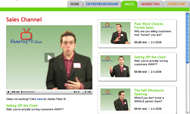 I’ve read 200+ books on creativity, many of which are, ironically, not very creative.
I’ve read 200+ books on creativity, many of which are, ironically, not very creative.
But.
Last week I finished an obscure, yet mind-blowing book called Playful Perception, by Herbert Leff.
I don’t even remember where I heard about it.
Either way, he suggests the following:
“Expand your repertoire of awareness. Increase the choice about the quality of your inner experience, and it will improve the flavor and value OF that experience.”
Nice.
This book is TRULY unlike any other I’ve ever read. I’m not even sure Leff intended it to be a book about creativity, but I guess it’s all in the eye of the reader.
Most of the book takes you through these “Awareness Plans,” which the author defines as “procedures or mental recipes for perceiving and thinking about the world around us.”
He suggests, “Concentrate your energy on thinking up original ways of experiencing that would help you solve your chosen problem or move toward your goal.”
Very nice.
SO, HERE’S THE SECRET: When we make a conscious choice about which Awareness Plan to use, everything changes:
We get more ideas. Because our brains are in a more receptive posture.
We enjoy more of life. Because our bodies are in a more relaxed posture.
We notice more of our surroundings. Because our senses are in a more astute posture.
To help apply these practices of creativity to YOUR world, I’ve extracted each of the forty-three Awareness Plans from the book. I’ve also added some commentary based on the experiences I’ve had with each of these practices in my own life.
As you explore this list, pick a few practices that resonate most with your daily life. Write them down. Post them on sticky notes. And start changing YOUR perception and experience of your world today!
1. BACK off mentally and include your own reaction to the situation as part of your overall awareness. Because emotional reactivity blocks listening and understanding.
2. BE willing to make the unusual assumption that perfection is unfolding right before your eyes. Because when you expect nothing, failure is impossible.
3. BECOME more aware of how the environment can shape your behaviors and feelings. Because context is everything.
4. BECOME unabashedly enthusiastic about your ideas, whatever they are. Because enthusiasm literally means, “to be filled with God.”
5. BROADEN and sharpen your sensitivity to alternative types of aesthetic value. Because it’s healthy for the soul.
6. CONTEMPLATE special contributions each thing makes to life. Because there is nothing that doesn’t matter.
7. DEFINE conflicts in terms of underlying needs instead of incompatible solutions. Because there’s always more than one solution to your problem.
8. DELIBERATELY evaluate everything in a different way. Because judgment creates labeling and labeling prevents understanding.
9. DREAM up a variety of alternative interpretations for the events you notice. Because the more you know about something, the more you can do with that something.
10. ENVISION what’s going on inside each thing you notice. Because it trains you to begin with fascination, not frustration.
11. FIGURE out people’s probable relations with each other. Because that’s just fun.
12. FIGURE out what the things and places around you communicate. Because there always exists a chasm between what we say and what people hear.
13. FIND special or unique value in everything you notice. Because that’s what the Dali Lama would do.
14. GET inspired by everything you see in site. Because everything is your Muse, if you allow it to be.
15. IMAGINE improvements in problem spots around you. Because it trains your brain to become a problem-solving maestro.
16. LEARN improvements in already pleasant things around you. Because it stretches your mind to make something great into something awesome.
17. LOOK at the world through different value systems. Because that’s the definition of empathy.
18. LOOK for recurring cycles of activities or repetitive patterns in your surroundings. Because he who notices the most patterns, wins.
19. LOOK for subtle external cues about what people are really like. Because silences speak volumes.
20. MAKE each moment into an opportunity for enriching life in some way, for making it more lovable. Because opportunity doesn’t stop knocking; only you stop listening.
21. MAKE predictions about what is going to happen around you in the next few seconds or minutes. Because it gives your intuition a solid work out.
22. NOTICE things you normally wouldn’t. Because noticing is basic to all victory in creativity.
23. PICK some ordinary things or situation and brainstorm all the reasons you can of for its perfection. Because everything is already perfect – you just need to recognize it.
24. PRETEND you always have a camera. Because your perception of color, shadow and poignancy heightens.
25. PROVOKE yourself to closer observation and renewed interest in your surroundings. Because, as Einstein said, “A wise man is astonished by everything.”
26. REGARD every moment as a new positive opportunity to exercise your choice about how to experience life. Because no matter what you see on Jerry Springer, you always have a choice.
27. REGARD everything as a possible inspiration for a new work of art. Because inspiration is everywhere.
28. REGARD whatever you’re doing as a game. Because it adds a childlike sense of playfulness and adventure to whatever you’re engaged in.
29. REGARD whatever you’re doing, thinking or feeling as if it were your hobby and transfer and echo of those emotions to the task at hand. Because it infuses your actions with love and joy and passion.
30. RELAX and assume everything is perfect so you can feel some rightness and complete appropriateness in what you’re doing. Because there are no emergencies. Ever.
31. SEARCH for boring things and then look for something interesting about them. Because creativity is about making the mundane memorable; finding interest and being fascinated by the ordinary.
32. SEE everything around you as alive. Because that will change the way you approach everything.
33. SEE things as events and not objects frozen in a moment of time. Because that will educate you about the process nature of all things.
34. THINK about what you would most like to know about the people and things you encounter. Because that instills a sense of curiosity that people can’t help but be attracted to.
35. THINK of every moment as an opportunity for choosing ways to experience and act. Because, once again, you always have a choice.
36. THINK of everyone and everything as really loving you. Because you will begin to feel welcome everywhere you go.
37. THINK of something as the title of a book and imagine what the book might include. Because as an author, I can tell you from experience that this is REALLY fun.
38. THINK of things you can learn from every encounter, especially from unusual sources. Because you can be mentored by anyone and anything, if you chose.
39. THINK of yourself as living in a shared pool of thoughts rather than as “possessing” or originating ideas. Because that will absolutely transform every meeting you have for the rest of your life. (Share this one with every coworker you have!)
40. THINK up actions that would lead to improvements you imagine by working backwards from your ideal future. Because this will help imagine what you need to become in order for your goals to manifest.
41. TRY not to change the situation, but think of some new ways to experience it that would make a positive difference in how you feel. Because once you change your relationship to your emotions, they can no longer boss you around.
42. VIEW disagreements as if they were celebrations or parties of ideas. Because that will absolutely transform every discussion you have for the rest of your life. (Share this one with every supervisor or manager you have!)
43. VIEW everyday things as if they were art exhibits. Because that compels you to appreciate the aesthetic beauty of everything.
LET ME ASK YA THIS…
What’s your Awareness Plan?
LET ME SUGGEST THIS…
For the list called, “10 Best Books on Creativity You’ve Never Heard Of,” send an email to me, and I’ll send you the list for free!
* * * *
Scott Ginsberg
That Guy with the Nametag
Author, Speaker, Coach, Entrepreneur
[email protected]
 Never the same speech twice.
Never the same speech twice.
Always about approachability.
Watch The Nametag Guy in action here!

 It’s not about the answer.
It’s not about the answer.
 1. Are you allowing yourself to create? It begins with permission. Returning to your childhood. As my friends Kim & Jason say, “
1. Are you allowing yourself to create? It begins with permission. Returning to your childhood. As my friends Kim & Jason say, “
 One of the great leverage questions you could EVER ask yourself is, “Now that I have this, what else does this make possible?”
One of the great leverage questions you could EVER ask yourself is, “Now that I have this, what else does this make possible?” My doctor, the great
My doctor, the great 
 1. Anytime you share link love, email the person you mentioned in your blog and thank them. They’ll probably find your post through their Google Alerts eventually, but still, a personal note from the actual blogger is always appreciated. It’s also more likely to stimulate word of mouth AND cement a new relationship, since it is grounded in value, respect and connectedness.
1. Anytime you share link love, email the person you mentioned in your blog and thank them. They’ll probably find your post through their Google Alerts eventually, but still, a personal note from the actual blogger is always appreciated. It’s also more likely to stimulate word of mouth AND cement a new relationship, since it is grounded in value, respect and connectedness. Let’s juxtapose two famous quotations, neither of which Google credits to any one source in particular:
Let’s juxtapose two famous quotations, neither of which Google credits to any one source in particular:
 This week my friend Paul asked me a solid question: “What are your All-Time Top Ten Branding Lessons Learned from 3,000 Days of Nametagging?”
This week my friend Paul asked me a solid question: “What are your All-Time Top Ten Branding Lessons Learned from 3,000 Days of Nametagging?”